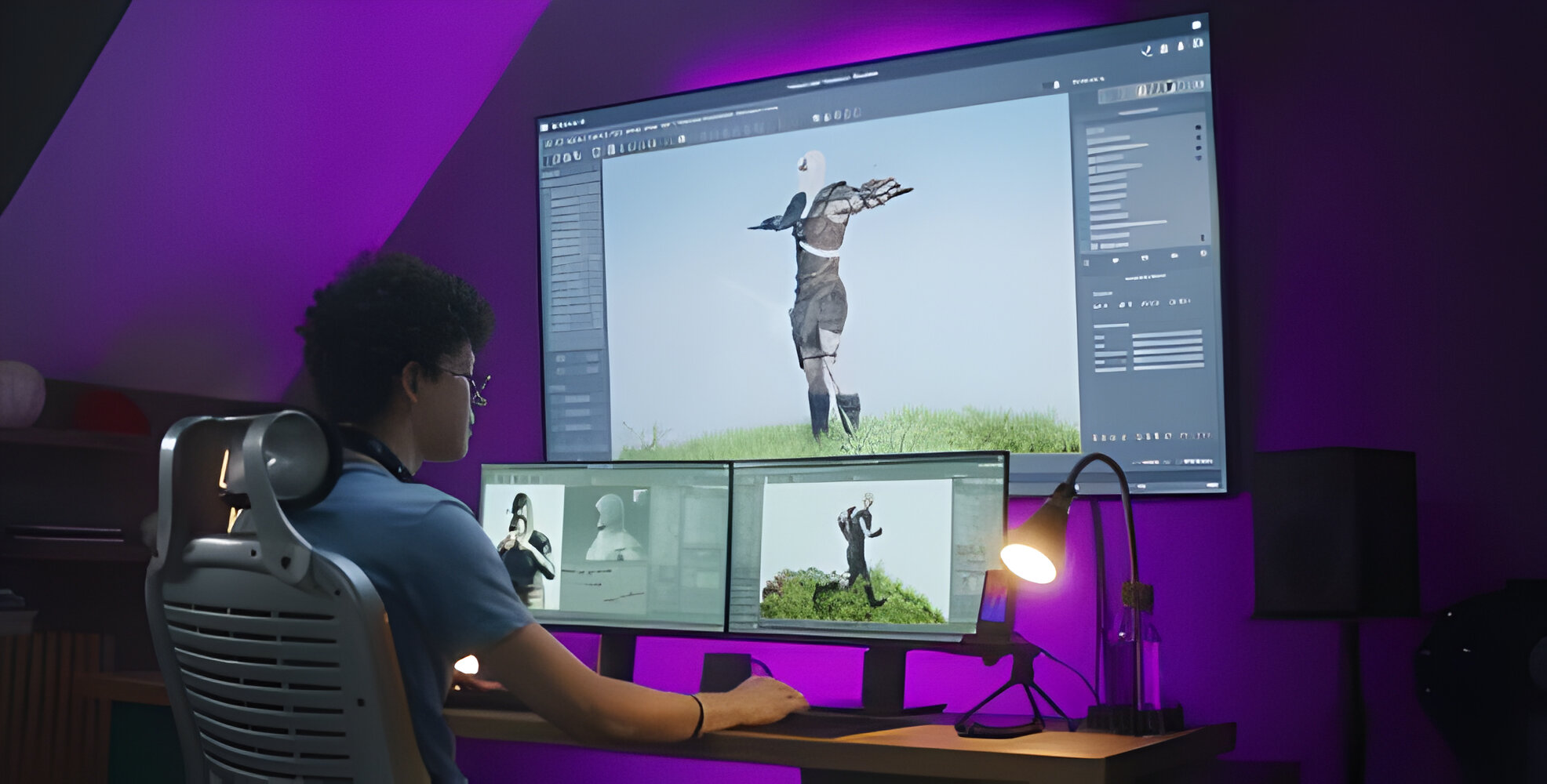The world of video games offers a vast array of experiences, but for aspiring developers, a crucial first decision is whether to create a game in 2D or 3D. While 3D games may seem to hold the upper hand with their immersive graphics, 2D games boast their strengths and continue to captivate players worldwide. This article explores the key differences between 2D and 3D game development to help you decide which approach best suits your next project.
Both 2D and 3D game development have their own set of advantages and disadvantages. 2D games are generally faster and easier to produce, making them ideal for smaller teams or those working with a tight budget. Additionally, the simpler art style of 2D games can lend itself to a wider range of artistic approaches. However, 3D games offer a greater sense of realism and immersion, potentially creating a more expansive and dynamic gameplay experience.
Key Differences in Visuals and Gameplay
The core difference between 2D and 3D games lies in their visual style and gameplay mechanics. 2D games are flat, with characters and environments built using sprites. This often leads to simpler controls, making them easier to pick up and play. Examples of successful 2D games include Hollow Knight and Super Meat Boy.
On the other hand, 3D games offer a more immersive experience with depth and realistic rendering. Characters can move freely in a three-dimensional world, allowing for more complex gameplay mechanics and control schemes. However, this complexity can also make 3D games more challenging to develop.
Choosing between 2D and 3D comes down to the experience you want to create. If you prioritize a simpler, more story-driven approach with a nostalgic feel, 2D might be the way to go. If you’re looking for a visually stunning and complex experience, 3D could be a better fit.
Why Choose 2D Games: Accessibility and Development Ease
There are several compelling reasons to choose 2D game development for your next project. Here, we’ll explore three key advantages:
- Simple Controls: One of the biggest strengths of 2D games is their accessibility. Since they operate on a flat plane, the controls are inherently simpler. Players typically only need to master a few basic commands to navigate the game world and interact with objects. This makes 2D games ideal for beginners and casual gamers who may be intimidated by the complexity of some 3D titles. A broader audience can enjoy your game, potentially leading to a larger player base.
- Faster and Easier Development: From a development standpoint, 2D games offer significant advantages. The creation of 2D art assets, like sprites and backgrounds, is generally less time-consuming and requires less technical expertise compared to 3D modeling and animation. This translates to faster development cycles and lower overall production costs. Additionally, updates and bug fixes tend to be more straightforward with 2D games, allowing you to keep your game fresh and engaging for players.
- Clear Goals and Focus: The narrative and gameplay objectives in 2D games are often more streamlined. Many popular casual games, known for their addictive pick-up-and-play nature, fall under the 2D umbrella. These games typically present players with a singular goal and clear instructions on how to achieve it within each level or stage. This focus can make 2D games particularly well-suited for specific genres, like puzzle or platformer games, where well-defined objectives are crucial for a satisfying player experience.
Why Choose 3D Games: Immersion, Visuals, and Variety
If you’re looking to create a truly immersive and visually stunning gaming experience, 3D game development might be the right choice for you. Here are three key reasons to consider:
- Enhanced Realism: 3D games excel at creating a realistic and immersive atmosphere. The three-dimensional environment allows players to feel like they’re truly in the game world. Developers can leverage detailed textures, lighting effects, and physics simulations to bring the world to life. This sense of realism is particularly appealing to dedicated gamers who crave a deeper level of engagement.
- Visual Spectacle: 3D games have the potential to push the boundaries of graphical fidelity. Modern 3D titles can boast stunning visuals with high-resolution textures, complex character models, and breathtaking environments. These advancements create a visually captivating experience that can keep players hooked for hours on end. The aesthetic appeal of 3D graphics can be a major selling point for many gamers.
- Genre Versatility: The world of 3D game development offers a vast array of genre possibilities. Unlike 2D games, which may be better suited for specific genres like platformers or puzzle games, 3D can accommodate a wider range of experiences. From action-packed shooters and sprawling RPGs to realistic sports simulations and open-world adventures, 3D allows for a level of complexity and depth that can cater to diverse player preferences. This versatility gives developers more creative freedom to explore different game concepts.
While both 2D and 3D games offer unique advantages, 3D development shines in its ability to create immersive, visually spectacular, and versatile gaming experiences. The choice ultimately depends on the specific goals and target audience of your project.
The Cost of 2D vs. 3D Game Development: A Variable Landscape
Determining the exact cost of developing a 2D or 3D game can be challenging. There’s no one-size-fits-all answer, as the price tag depends on a multitude of factors. However, we can explore some general ranges and key considerations to help you budget for your project.
2D Games: Faster, Simpler, More Affordable
Generally, 2D game development boasts a simpler and faster process compared to 3D. This translates to a more manageable cost range. Depending on the complexity of your game’s features and desired performance, you might expect to pay somewhere between $50,000 and $100,000 for a 2D game.
3D Games: The Potential for Higher Costs
While there’s some overlap, 3D game development typically falls within a wider cost range of $60,000 to $300,000 or even more. This increased cost reflects the additional complexity involved in creating 3D graphics, characters, and environments. Here, factors like the number of features and the intricacy of the gameplay mechanics play a significant role in determining the final price.
Real-World Examples: A Spectrum of Costs
For illustration purposes, consider the vastly different costs of Flappy Bird, Candy Crush, Grand Theft Auto 5, and Pokemon Go. Flappy Bird, a relatively simple 2D game, reportedly cost around $3,000 to develop. In contrast, Candy Crush, a more feature-rich 2D game, is estimated to have cost around $100,000. Jumping to the world of 3D games, Grand Theft Auto 5, a sprawling and highly detailed open-world title, boasts a staggering development cost of $265 million. On the other hand, Pokemon Go, a 3D game with augmented reality elements, reportedly cost roughly $650,000 to create. These examples highlight the immense range of development costs within both 2D and 3D game creation.
Key Cost Factors to Consider
Here’s a breakdown of some key factors that can significantly impact the cost of your game development project:
- Game Engine: The specific game engine you choose can influence the development cost.
- Graphics Quality: The level of detail and complexity of your 2D or 3D graphics will affect the price.
- Gameplay Mechanics: More intricate and innovative gameplay mechanics typically require a higher investment.
- Soundtrack and Sound Effects: Licensing or creating a high-quality soundtrack can add to the cost.
- Project Management: Effective project management is crucial and factors into the overall budget.
- Development Team: The size and experience level of your development team will impact the cost.
- Development Approach: Developing the game in-house, outsourcing it, or using a combination can affect the budget.
Choosing the Right Game Development Company for Your Project
The video game industry is a booming business, with new titles emerging at a rapid pace. However, with so many game development companies vying for your attention, selecting the perfect partner for your project can be daunting. Here, we’ll explore some key factors to consider to ensure you make an informed decision.
There’s a lot at stake when you entrust your game idea to a development company. Your resources, both financial and creative, deserve to be placed in capable hands. By carefully evaluating potential partners based on the following criteria, you’ll increase your chances of finding a company that can turn your vision into a reality.
Company Portfolio
A strong portfolio is a window into a game development company’s capabilities. Look for a company with experience in creating games similar to your vision. Their website, social media channels, and client testimonials can offer valuable insights into their past work and client satisfaction. For example, a company that specializes in fast-paced action games might not be the ideal fit for a turn-based strategy title.
Range of Services
Explore the different services offered by potential game development companies. Do they have experience with both 2D and 3D development, or do they specialize in one or the other? If your game requires cutting-edge features like blockchain integration or metaverse compatibility, ensure the company has the expertise to deliver.
Technical Expertise
A skilled development team is crucial for bringing your game to life. During your initial consultations, discuss the team’s experience with various game engines, programming languages, and frameworks. Consider conducting one-on-one meetings with key team members to gauge their technical abilities and communication styles.
Client Reviews and Testimonials
Don’t underestimate the power of client feedback. Look for reviews and testimonials on the company’s website or through reputable third-party platforms like Clutch and GoodFirms. These can provide valuable insights into the company’s communication skills, project management approach, and overall client satisfaction.
Company Size and Experience
There are advantages and disadvantages to working with both large, established studios and smaller, more specialized teams. Consider the scope of your project and your desired level of collaboration when making this decision. It’s also important to assess whether the company’s experience aligns with your project’s genre and target audience.
Ready to Get Your Dream Game Developed?
2D or 3D? It’s an important decision but remember: your vision is king. The choice should enhance your game, not the other way around.
Finding a development partner who listens is crucial. Collaboration is key to translating your vision into a successful game.
Ready to bring your dream to life? We can help! For over 5 years, we’ve turned ideas into realities in both 2D and 3D. We believe in strong partnerships and clear communication. Our award-winning team will work closely with you to create a game that stands out.
Visit our website to learn more and let’s make your dream game a reality!



